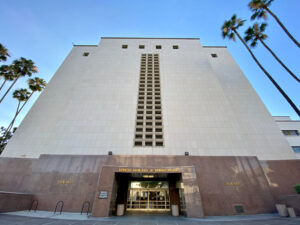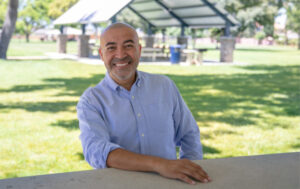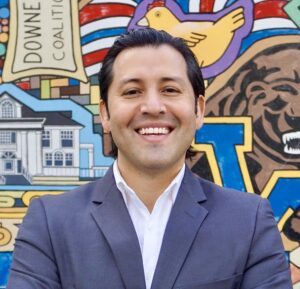Layla Hernandez
Real estate broker Rudy Sandoval is running to represent District 5, which includes the entire city, on the Downey City Council.
Nov. 5 is the last day to vote, with early voting available. To check registration status, request a vote-by-mail ballot, or find a local voting center, visit lavote.gov.
When discussing their visions for the city, Sandoval focuses on a future of “economic prosperity for all,” with an emphasis on diverse job opportunities and sustainable development, touching on issues like homelessness and inclusivity and including “family values” messaging.
Sandoval gives a somewhat inconsistent response on rent stabilization. He states that he is undecided on the issue, but later suggests it as a possible solution to prevent residents from being priced out of the city. He notes the importance of a “balanced approach.”
Sandoval presents a range of alternative public safety strategies, such as crisis response teams and community-based programs, while Trujillo stands firmly behind increasing the police budget, highlighting his efforts to hire more officers and improve surveillance.
Sandoval has lived in Downey for over 12 years.
Responses have been lightly edited for clarity. The candidate self-reported their occupation and residence.
Why are you running?
Meet Rudy: A Passionate Leader for a Better Downey
As a lifelong Downey resident and real estate professional, I’m excited to run for City Council in 2024. With decades of community service and a deep love for our city, I’m committed to bringing justice, humility, and self-control to local government.
As a Downey native since 1987, I’ve seen growth and evolution, including homelessness and economic inequality. I’m running to tackle these issues head-on and make a positive impact.
As a dedicated professional, I’ve built a reputation for being results-driven, fair-minded, and committed to creative solutions. As your Councilmember, I’ll:
- End homelessness with affordable housing and social services.
- Foster economic growth with new businesses, entrepreneurship, and infrastructure.
- Promote justice with equal access, public safety, and transparent government.
I promise to listen to your concerns, be transparent in my decision-making, and work collaboratively with residents, business owners, and city staff to build a brighter future for our community. Join me in this exciting endeavor! Elect Rudy for Downey City Council in 2024, and let’s build a better Downey for all.
What is your vision for the future of the city?
Vision for the Future of the City: A Prosperous Community with Compassion and Family Values
1. Economic Prosperity for All:
Our vision is to foster a thriving economy that provides ample opportunities for every resident. We will work towards creating diverse job opportunities by attracting new businesses and supporting local entrepreneurship. Investments in technology, green industries, and the arts will ensure that our economy is resilient and adaptable to future challenges. Skills training programs and partnerships with educational institutions will empower residents to gain the skills needed for the jobs of tomorrow, ensuring that everyone can participate in and benefit from the city’s prosperity.
2. Comprehensive Support for the Homeless:
We envision a city where homelessness is addressed with compassion and effective solutions. By collaborating with non-profits, local businesses, and community organizations, we will develop comprehensive support systems that provide not only shelter but also medical, psychological, and job training services. Emphasizing transitional housing and personalized support programs, we aim to guide individuals toward stability and self-sufficiency. Our goal is to provide a pathway from homelessness to permanent housing, fostering a community that values every individual and recognizes their potential.
3. Family Values at the Heart of Community Life:
We believe that strong family values are the foundation of a vibrant community. Our city will prioritize initiatives that support families, such as accessible childcare, family-friendly public spaces, and recreational activities that foster connection. We will promote educational programs that teach values of respect, empathy, and community service, ensuring that the next generation grows up with a strong sense of social responsibility. Community events and festivals will celebrate diversity and foster relationships among families, creating a sense of belonging and unity.
4. Inclusive Civic Engagement:
In our vision, the voices of all residents, especially those most affected by homelessness and economic disparity, will be heard and valued in civic decision-making. We will create forums and platforms for community members to share their ideas, concerns, and aspirations. By empowering residents to take an active role in shaping their neighborhoods, we will build trust and foster a sense of ownership and pride in our community.
5. Sustainable Development and Environmental Stewardship:
A prosperous future for our city must also prioritize sustainability. We will promote green infrastructure, support local agriculture, and enhance public transportation options to reduce our environmental footprint. Community gardens, parks, and green spaces will be integral parts of our neighborhoods, providing not only recreational opportunities but also contributing to the health and well-being of our residents.
Conclusion:
Our vision for the future of the city is one where prosperity is inclusive, compassion for our neighbors in need is paramount, and family values are woven into the fabric of our community. Together, we can create a vibrant, resilient city that uplifts every resident and stands as a beacon of hope and opportunity for generations to come.
The average monthly rent for an apartment in Downey is $2,241, up 11% from January 2022, according to the apartment search website rentcafe.com. Multiple cities in Southeast Los Angeles County have placed caps on annual rent increases beyond the hard cap of 10%–5% plus inflation or 10%, whichever is lower–passed by the state in 2019. Bell Gardens set a cap of 50% of inflation or 4%, whichever is less; Maywood’s maximum rent increase is 4%; Cudahy’s cap is the change in inflation or 3%, whichever is less. Do you support a cap on annual rent increases in Downey beyond the state cap?
Undecided. As an undecided response regarding a cap on annual rent increases in Downey beyond the state cap, I recognize the complexities of housing affordability and the potential impact on both tenants and landlords. On one hand, a lower cap could provide much-needed relief for renters facing escalating costs, promoting stability in the community. On the other hand, overly restrictive caps might discourage investment in rental properties and maintenance, potentially leading to decreased housing quality. It’s essential to consider a balanced approach that involves stakeholder input, equitable solutions, and monitoring to ensure the long-term health of the housing market.
What are other solutions to prevent renters from being priced out of the city due to rising costs?
There are several strategies that cities and communities can consider to prevent renters from being priced out due to rising rents. Here are some potential solutions:
1. Rent Control and Rent Stabilization : Implementing policies that limit the amount landlords can increase rents annually, protecting tenants from sudden price hikes.
2. Affordable Housing Development : Encouraging the construction of affordable housing units through incentives for developers, inclusionary zoning, or funding for non-profit housing organizations.
3. Housing Vouchers and Subsidies : Expanding access to housing vouchers and rental subsidies that help low- and moderate-income families afford market rent.
4. Property Tax Relief for Renters and Landlords : Offering tax incentives to landlords who keep rents affordable or providing property tax relief to low-income renters.
5. Community Land Trusts : Establishing community land trusts that allow communities to collectively own and manage land. This can help keep housing affordable as the property is not sold on the market.
6. Enhanced Tenant Protections : Strengthening tenant rights and protections against eviction, harassment, and retaliatory behaviors to provide a more secure rental environment.
7. Short-Term Rental Regulations : Implementing regulations on short-term rentals (like Airbnb) to keep more long-term rental units available for residents and reduce competition for housing.
8. Land Use Reforms : Reforming zoning laws and land use regulations to allow for higher-density housing developments, mixed-use areas, and accessory dwelling units.
9. Cooperative Housing Models : Promoting cooperative housing organizations where residents collectively own and manage their building, allowing for shared decision-making and cost savings.
10. Incentives for Long-Term Tenancy : Offering benefits or incentives for landlords who provide long-term leases or retain tenants for extended periods.
11. Public-Private Partnerships : Collaborating with private developers to create affordable housing projects in exchange for zoning allowances or subsidies.
12. Investment in Support Services : Providing support services for low-income renters, such as financial literacy programs, job training, or access to resources that can help stabilize families financially.
13. Local Housing Trust Funds : Establishing or expanding local housing trust funds that can provide financing for affordable housing projects and emergency funds for renters in crisis.
14. Regular Market Assessment : Conducting regular assessments of the local housing market to identify trends and areas needing intervention, ensuring proactive policy responses.
15. Community Engagement : Involving residents in the decision-making process around housing policies to ensure that the solutions reflect the needs and realities of the community.
Implementing a combination of these solutions can help create a more balanced housing market and reduce the likelihood of renters being priced out of their communities.
The police department makes up 38% of the city budget. Do you think this is the right amount of spending? What public safety strategies do you think the city could implement that don’t rely on traditional policing?
Cities can explore various public safety strategies that do not rely solely on traditional policing. Here are some alternative approaches to enhance public safety while fostering community trust and engagement:
1. Community-Based Safety Programs : Implementing programs that involve community members in safety efforts, such as neighborhood watch groups, community patrols, or safety ambassadors who are trained to de-escalate tensions and assist in emergencies.
2. Crisis Response Teams : Establishing teams that include mental health professionals, social workers, or trained mediators to respond to behavioral health crises, homelessness, or substance abuse issues instead of law enforcement.
3. Restorative Justice Initiatives : Implementing restorative justice practices that focus on mediation and agreements between the victim and the offender, aiming for resolution and community healing rather than punitive measures.
4. Investment in Community Services : Enhancing funding and support for social services, including mental health services, addiction treatment programs, housing assistance, and youth development initiatives, to address root causes of crime and promote well-being.
5. Public Safety Hubs : Creating community centers that serve as resource hubs for residents, offering access to services, information, and community support to help build social cohesion and reduce reliance on policing.
6. Neighborhood Revitalization : Investing in infrastructure improvements, public spaces, parks, and community facilities to foster a sense of belonging and safety, thereby reducing crime through environmental design.
7. Community Mediation Programs : Establishing mediation services to help resolve conflicts within neighborhoods before they escalate to violence or involve law enforcement.
8. Alternative Transportation Initiatives : Improving community transportation options, such as increased public transit, bike lanes, and walkability features, to reduce isolation and enhance access to resources.
9. Engagement and Training for Local Businesses : Offering training for local businesses on crime prevention strategies, conflict resolution, and community engagement, encouraging them to play an active role in neighborhood safety.
10. Youth Engagement Programs : Developing programs aimed at youth engagement, including mentorship, job training, sports, and arts initiatives that provide positive outlets, reduce delinquency, and create community ties.
11. Hotline and Reporting Systems : Establishing anonymous reporting systems or hotlines for community members to report issues or concerns without requiring police involvement, such as violence, noise complaints, or disputes.
12. Bystander Intervention Training : Providing training for community members on how to intervene safely in potentially dangerous situations, fostering a culture of proactive safety among residents.
13. Public Health Approaches : Treating public safety as a public health issue by analyzing crime and violence data and developing preventive measures to address underlying social determinants, such as poverty and access to education.
14. Building Trust and Communication : Fostering open communication between residents and city officials through regular community meetings, surveys, or advisory boards to ensure that the community’s needs and concerns are addressed collaboratively.
15. Dispute Resolution Centers : Establishing centers focused on resolving conflicts through negotiation and mediation instead of law enforcement involvement.
By diversifying approaches to public safety and emphasizing community engagement, education, and support services, cities can create more holistic, effective, and equitable safety strategies.
Should the police budget increase, decrease, or stay the same?
Stay the same.
The 2015 Downey Bicycle Master Plan proposes 33.6 miles of added bike lanes in the city, though the city currently only has just over 5 miles of bike lanes. If elected, what steps would you prioritize to improve non-motorized travel, especially biking infrastructure, and how will you ensure the city remains on track with these goals?
To improve non-motorized travel and biking infrastructure, I would prioritize:
1. Developing a Comprehensive Bike Network : Create dedicated bike lanes, paths, and bike-sharing programs.
2. Upgrading Traffic Safety : Install bike-specific signals, signage, and crosswalks.
3. Community Engagement : Involve residents in planning to ensure user-friendly designs.
4. Regular Maintenance : Implement scheduled upkeep of bike paths.
5. Monitoring and Evaluation : Establish metrics to assess usage, safety, and satisfaction regularly.
To stay on track, I would implement quarterly reviews, engage stakeholders, and create an advisory committee to ensure accountability and adaptation of goals.
https://www.downeyca.org/our-city/departments/police/crime-prevention-and-safety/bicycle-safety







